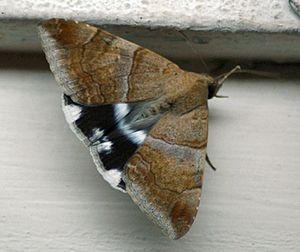Castor semi-looper facts for kids
Quick facts for kids Castor semi-looper |
|
|---|---|
 |
|
 |
|
| Scientific classification | |
| Synonyms | |
|
The Achaea janata, also known as the castor semi-looper or croton caterpillar, is a type of moth. Its caterpillars are called 'semi-loopers' because of how they move. They look like they are looping as they walk.
You can find this moth in warm, tropical, and subtropical areas. This includes places from India and Australia all the way to New Zealand and islands in the Pacific Ocean, like Easter Island. It is known as a major pest for the castor plant around the world.
Contents
What Does the Castor Semi-Looper Look Like?
The Adult Moth
The adult moth has a wingspan of about 60 to 70 millimeters. This is about the size of a small ruler. Its body is a pale reddish-brown color.
The front wings have clear patterns. They have wavy lines and a small black spot. The back wings are black with a white band in the middle. They also have three large white spots along the outer edge.
Eggs, Pupae, and Caterpillars
The eggs of the castor semi-looper are small, round, and greenish. The pupa, which is the stage before the moth, is whitish-green.
The caterpillar is bluish-grey with black speckles. Its head has black stripes. It has yellowish bands along its sides. There is a black stripe on its back with reddish-white spots. The caterpillar also has a pair of red bumps near its tail. Its breathing holes (spiracles) and front legs are red.
Caterpillars grow through four stages, called instars, before they become a pupa.
What Do They Eat?
These caterpillars eat many different plants. They especially like the castor oil plant (Ricinus communis). They also feed on plants like Brassica (which includes cabbage and broccoli) and Ficus (fig trees).
Other plants they eat include peanuts, citrus fruits, soybeans, pomegranates, roses, tomatoes, and cacao trees.
How Do They Affect Plants and How Can We Control Them?
Plant Damage
Castor semi-looper caterpillars can cause a lot of damage to plants. They eat the leaves, which can strip the plant bare. When leaves are gone, the plant cannot make enough food through photosynthesis.
They can also bore into the stems of plants. This can make the whole plant wilt and die. Because they eat plants like the castor oil plant, which can be toxic, it's always best not to touch unknown caterpillars.
Controlling the Moths and Caterpillars
People use different ways to control these moths and caterpillars. These methods include physical removal, using natural enemies, and sometimes special sprays.
- Hand Picking and Traps: You can pick off the caterpillars by hand. Farmers also use special traps, like pheromone traps and light traps, to catch the adult moths.
- Natural Enemies: Many tiny insects, called parasitoids, help control the caterpillars. These are like natural pest controllers. For example, Trichogramma evanescens can destroy the eggs. Microplitis maculipennis attacks the caterpillars. Other helpful insects include Euplectrus and Rhogas.
- Sprays: Sometimes, special sprays are used to protect crops. Sprays made from neem seed kernel extract are a natural option that can destroy the eggs.






